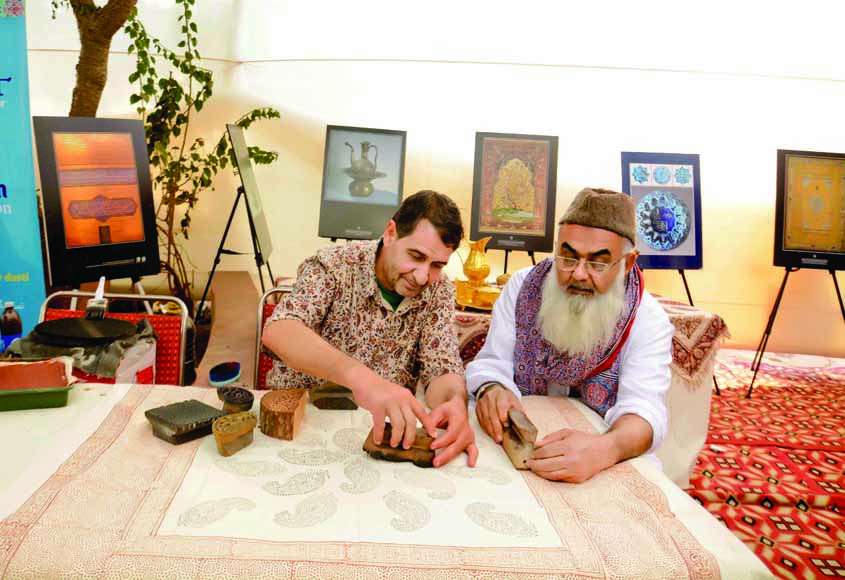“We are working on a 15-page booklet which will contain these Indian and Iranian arts,” says Lakhiwal who has been working as a miniature painter for more than two decades. “Having been in this profession for many years, I understand it is an important part of our tradition and would like it to reach far and wide. I think this cross-cultural exchange will facilitate it. The booklet will be distributed across multiple sectors and consequently the arts will be
noticed.”
As part of the 31st edition of annual Dastkaari Haat Craft Bazaar, nine craftspeople/artists/calligraphers from Iran have come to India. The artists, along with their Indian counterparts, are aiming to revive the old civilizational and creative links between the two countries. The products that arise from this unique India-Iran collaboration will be displayed on 14 January at Dilli Haat. The India – Iran Crafts Exhibition is titled Namayeshgahsanaye-E -Dasti Iranva Hind.
“Since 2004, we have been calling people from craft-rich countries to work with us,” says Jaya Jaitly, president, Dastkari Haat Samiti. “We feel that with countries rich in craft, we have a lot to share, learn and exchange. I also wanted the Iranian craftsmen to see Dilli Haat which is promoting crafts in India and giving space to people to market, especially people who don’t have shops or any other opportunities to sell. I started with Pakistani artists calling it “Dostkari”, meaning dosti and dastkari. After this, craftsmen from various other countries like Sri Lanka, South Africa, Vietnam and other places were called.”
Talking about the criteria for selection of the Iranian artists, Jaitly says, “I thought about the ways they could be matched with our people. I also looked for old cultural connections or aesthetic or a design connections. Somewhere in olden times, certain old crafts and ideas have travelled to India and there may have been things that Iranians have learned from India. Even if there is a slight difference in technique between these two countries’ compositions, it is interesting because one can learn from each other in many ways. Now, as they are working together despite having no knowledge of each other’s language, there is an appreciation. Craft brings the ability to communicate.”

Clearly, communication was not a barrier for Abdul Razak Khatri from Gujarat and Murtaza Jaffrey from Iran. The block printing artists were appreciating each other’s company. Each of them had brought blocks bearing vivid motifs from two different countries. It is interesting to note that the word Qalamkari (block printing) originated from Persia, where Qalam means pen and kari means craftsmanship “The style employed by both of us are similar in nature,” says Jaffrey. “However, the difference lies in cloth. Iranian cloth is thicker in quality which takes a considerable amount of time in execution of a certain design. If we get the Indian cloth which is light, we can make a variety of designs and our production can increase manifold. As of now, we can’t import the cloth due to various bans. I am fortunate enough to learn from Khatri and would love to come here again.”
Collaborative work, especially in arts and culture transcends the boundaries between states. More often than not, it lets the artist into a totally new macrocosm of culture where they can gain inspiration, use juxtaposition and eventually bring into existence an entirely new body of art which otherwise they wouldn’t have even imagined to be present. The experiments can be rich and diverse where the artists can play with various art forms.
In the past, pop artist Andy Warhol and graffiti artist Jean Michael Basquirat have worked together and generated multiple paintings. Similarly, the storyboard for the movie Destino was made by surrealist painter Salvador Dali and John Hench, a studio artist from the Walt Disney Company.
The India-Iran Crafts exhibition is not just focusing on collaborative workshop and interactions but also individual arts and crafts from these artists. Gholameraza Emami and Kamran Baghban from Iran are presenting their Meenakari designs and paintings at the event. “After coming here, I have noticed that the patterns of dress in Indian and Iranian paintings are similar but the face cut varies,” says Baghban.
Annual Dastkari Haat Craft Bazaar is on at Dilli Haat till 15 January

